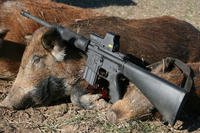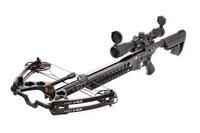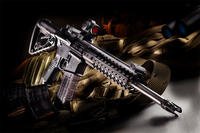Avoiding these 13 blunders will keep your rifle healthy, accurate, and out of the shop.
by Kevin Muramatsu
Every firearm design has idiosyncrasies that need to be understood and addressed. One characteristic of the AR's direct impingement gas system, which lends itself to superb accuracy, comes with trade-offs. In this case, the rapid build up of fouling in the receivers of ARs. With that inevitable fouling comes certain "Must-Dos."
Here we cover some of the "blunders" associated with the AR. They are mostly avoidable, usually a result of the owner being new to the rifle, or in a few cases, perhaps so used to the rifle that they take it for granted and get lazy.
Blunder 1: Clean your @$#&%$* rifle!
Every firearm will fail or malfunction, sometimes very badly, when it has built up crud. Even if you only shoot a few rounds to check your zero before the hunt, and then one or two during the hunting season, you must thoroughly clean your firearm prior to storage. This is a no-brainer that some shooters don't quite compute. Forget this and problems are assured.
Dirty Reciever - Several hundred rounds have been fired through this gun. It needs to be cleaned. Wearing the anodizing off is normal wear and tear, unless the wear is clearly not uniform or it is localized, but deep.
Blunder 2: Wiping off the outside of the bolt carrier group is only half the job.
When cleaning the carrier group, take it apart and clean the bolt, firing pin, and cam pin as well. It takes a few minutes, and Hoppes #9 or any of today's modern solvents will clean all of it well. The more you allow build up on the bolt, the harder it will be to chip off later. Frequent cleaning is simpler and faster than a scrub job after a lot of use.
Take the bolt carrier group apart completely. If this stuff is very dirty, you may also need to remove the extractor from the bolt to clean out beneath it. There is no need to remove the shiny split ring gas rings around the rear of the bolt unless they are broken or bent.
Blunder 3: Attempting to make a match grade trigger pull with factory fire control parts.
You can't do it. Don't try. Factory standard parts are not designed to be adjustable or glass smooth. Just shell out the money to buy a quality fire control group like those available from JP Enterprises, Geiselle, or Timney.
If you want a high quality super nice trigger, you have to get a match trigger. The factory standard trigger and hammer on top simply cannot be tuned to the same level as the match trigger with overtravel and sear adjustment, and low mass hammer, like the set above.
Blunder 4: If it's on the Internet, it must work.
A popular method found on the web for reducing trigger pull weight is to flip around the hammer spring. This will prevent reliable primer ignition. Springs are designed to work in one direction, and reversing the spring will result in misfires. Several companies offer reduced or even enhanced weight hammer springs and trigger return springs. Flipping your factory hammer spring is just plain dumb.
On the right is the proper alignment of the hammer spring. Incorrect installation is indicated on the left. Buy a reduced power spring to lighten trigger pull weight.
Blunder 5: Double tapping.
Lots of guys think their rifle went Arnold on them, when all they did was unknowingly pull the trigger again on the recoil. The fault lies with the shooter, poor trigger control and a trigger that is too light. Control your finger and get a heavier trigger.
Changing the trigger pull and reset weight can do wonders. Doubling? Use a mil-spec trigger return spring, like the one on the lower left to increase trigger tension. Pull too heavy? Use a reduced power hammer spring like the red or yellow springs at the top right. The hunter could also work on better trigger control in conjunction with these.
Blunder 6: Soft primers.
Using soft primers when reloading can result in a slam fire. ARs have a floating firing pin that will make a small indentation in the primer when the cartridge is fed into the chamber. Very soft primers have been known to ignite on occasion because of this. Most primers are fine, but CCI No. 41 5.56 mm primers are the best remedy for this pox.
Note the slight indentation on the primer. This is normal, but if the primer is very soft, it’s possible that a slam fire may occur. Try to reload with harder primers such as the CCI No. 41.
Blunder 7: Not gauging brass.
You're shooting a semi-auto rifle here. Buy a case gauge and gauge all your resized brass for overall length and expansion, and reject any that fail. Cases that don't gauge can jam easily, not chamber properly, or worse — lock up.
Buy a case gauge to assure your resized brass will not ruin your day. If it doesn’t pass go, resize it or discard it. Semi auto firearms are very sensitive to poorly sized brass, and may not feed, extract, or may even cause pressure problems.
Blunder 8: Removing fire control for routine cleaning.
Don't punch out the hammer and trigger pins for field cleaning. The pin holes will wear out very quickly. Shoot solvent in the lower, toothbrush it, and then blow it out with air. Don't make work when it's not necessary.
Blunder 9: Not using a free float handguard tube.
ARs meant for hunting should have free floated barrels to enhance accuracy. Any competent gunsmith can install a handguard that will float your barrel to avoid accuracy stealing contact, and there are many inexpensive options available. And remember, sling on the handguard, not the barrel.
Free floating the barrel removes any remaining stresses from the barrel. Your rifle’s accuracy will improve. Take note how the barrel and gas tube stay completely clear of the handguard. Standard handguards grasp the barrel right at the gas block.
Blunder 10: Using the forward assist.
Pretend it doesn't exist. If the bolt won't close and lock, clean the gun. Don't wedge the bolt home with the forward assist. That button can turn a simple problem into a major catastrophe. Forget it — it isn't there.
Don’t use this button if your action won’t close. Using it will only jam the action closed. Life would be better if the button just didn’t exist. Consider it verboten and ignore it entirely. Avoid the temptation to use it by keeping your rifle clean.
Blunder 11: Using .223 as a do-all.
AR modularity has spawned a number of larger calibers, all better than .223 for big game. Don't use a .223 on anything bigger than coyotes unless you use specialty handloads. More appropriate big game options from 6.8 mm to .450 SoCom are just drop in uppers. Use them!
Blunder 12: Cheap ammo
Let someone else use the imported steel cased ammo. Stick to domestic factory ammo or your own quality reloads. Remember how much you paid for the rifle, a shame to blow it on cheap ammo.
Blunder 13: Don't mess with the gas port in the barrel.
Just don't. This won't fix your problem. 99 percent of the time, the problem lies elsewhere and dinking with the gas port can turn a fixable problem into a permanent problem.
Removing this sight tower is a pain. Have a gunsmith do it. If you have cycling problems, removing this sight to investigate, or open up the gas port, is an absolute last resort. It’s usually ammo related, but check elsewhere, like excessive gunk in the bolt carrier group, damaged gas rings, obstructed carrier key, junk stuck in the chamber, or just plain general dirtiness.















